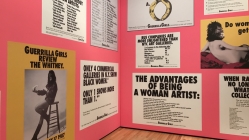The Guerrilla Girls made their final mark at the Baltimore Museum of Art this week after a six-month display of calling out gender inequality. Since 1985, the Guerrilla Girls have used their platform to bring attention to gender inequality in art, business, politics, film and everyday life. On their self-titled website GuerrillaGirls.com, one of their mission statements is that they “believe in an intersectional feminism that fights discrimination and supports human rights for all people and all genders.”
If you don’t know the name of any of the artists that contribute to the movement, that is intentional. If you don’t know any of their faces, then that might be due to the fact they never appear without wearing gorilla masks.
As a group of over 55 women activists, artists, designers and writers over the years, they have kept their identities anonymous as a higher level of activism. While bringing attention to their art and their purpose as a group, omitting their own identities is a way for them to the assume identity of all women. The founding members have adopted pseudonyms like Frida Kahlo and Käthe Kollwitz — both well-known women artists who played a part in the cause — in order to make themselves identifiable.
At the BMA, the exhibit was held in the Contemporary Art wing with four brightly colored walls. With floor to ceiling posters, the exhibit was not just there to be noticed, it demanded to be observed. The posters posed questions to onlookers that brought both humor and reality to the situation. Hung and separated according to the year they were created and it was interesting to see just how creative they were with each new piece. The history meshes together as one piece, showing how present the inequality is and how critical it is to bring attention to what still needs to change.
One piece that was included in both the 1987-1989 and 2001-2012 section depicts a naked woman wearing a gorilla mask, asking, “Do women have to be naked to get into the Met. Museum?,” clearly mocking how women artists and women in art are displayed very differently. The punchline comes in when onlookers realize that the exhibit itself is speaking out against the museum and their discriminatory practices.
While focusing on a topic that has obviously plagued women for so long, the posters hang in a manner that doesn’t hold back, throwing witty metaphorical punches left and right. They mimic the style of newspaper headlines, advertisements, handwritten notes and Q&A’s. In the more recent additions, bright colors and graphics draw the eye to the irony and statistics of how women are treated unfairly in these situations.
In a fabricated movie poster for “the Birth of Feminism,” the catchphrase “They made women’s rights look good. Really good” attacks the film industry with the idea that three attractive actresses are what it takes for them to take notice of feminism — all the while, creating movies that go against what it really stands for.
Beyond the entirely unapologetic campaigns they display all of the world, the Guerrilla Girls take the time to come to museums and universities to hold discussions about their purpose and why it is so important for them. They even hold personal workshops to show women and men alike, just what it takes to participate in your own feminist and activist projects. Each appearance isn’t complete without their gorilla masks, making a statement that they are indeed an army with guerrilla tactics.


